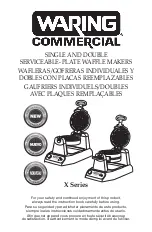
8
To remove door from hinges:
1. Remove the top hinge cover.
2. Using a Phillips screwdriver, remove the screws, then remove top hinge mat and top hinge. Keep
the parts together and set them aside.
3. Lift the door off the bottom hinge and set it aside.
To replace door on hinges:
1. Using a flathead screwdriver, remove the plug buttons from the screw holes opposite the door
hinges, top and bottom. Set aside.
2. Remove the front louver. Set aside.
3. Remove the bottom hinge and place it on the opposite side at the bottom of the door.
4. Position the door on the bottom hinge.
5. Align the door on the bottom hinge and replace the top hinge and top hinge mat.
6. Replace top hinge cover.
7. Push the plug buttons into the original screw holes
See Figure below:
Water Supply Connections
The water supply should be ready at the point of installation. The water supply pressure should be a
minimum of 15 psi with a static pressure not more than 80 psi. (A wall outlet directly behind the ice
maker will make installation easier.)
IMPORTANT:
1. All installations must be in accordance with local plumbing code requirements.
2. Make certain that the pipes are not pinched or kinked or damaged during installation.
3.
Check for leaks after connection.
Tools required: ½ in. open-end wrench, Phillips screwdriver
Connecting the water line:
1. Turn off main water supply. Turn on nearest faucet long enough to clear line of water.
2. Find a ½ in. to ¾ in. vertical cold water pipe near the installation location. The distance should be less
than 9 feet. The water supply hose provided with the ice maker is about 9 feet long.
3. A shut-off valve must be installed to the main water supply. If the water pipe has a plain piece of
copper tubing, attach a ¼” O.D. compression union to the tubing and remove the nut.



































